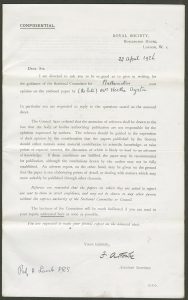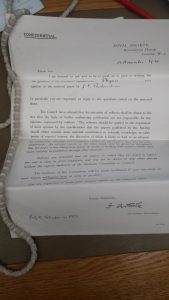In the 1890s, the Royal Society had introduced a set of 7 questions for referees, in the hope of structuring the reports (which were sometimes extremely long-winded!). These were originally hand-written into the covering letter, but were quickly turned into a printed standardised report form, sent to each referee with the manuscript to be evaluated. Referees were encouraged to return their reports within 14 days – a deadline that was routinely breached.

By the early twentieth century, these report forms included clear instructions for referees, including advising them of the confidentiality attached to the papers referred to them (see image). It was routine for the author’s name to be written on the form: refereeing was single-blind, not double-blind. At this time referees were always Fellows of the Society (and their names and reports were kept confidential), but the majority of papers came from those outside the Fellowship.
The report forms made it possible for a referee to present an extremely succinct report, as was the case with Professor H. Lamb’s report on this 1925 paper by ‘Mrs. H. Ayrton’. Hertha Ayrton’s work in electrical engineering had previously been published with and exibited to the Society, but her status as a married woman had prevented the Royal Society accepting a fellowship nomination certificate in her name in 1902. (Her husband was also a well-known electrical engineer, and Fellow of the Royal Society, William Ayrton.)
The printed forms were also an attempt to standardize the refereeing process, or to at least advise referees on how to write an effective report. The Society never officially instructed referees until this date; referees were automatically expected to know how to write a report. Guidance on this continued to develop. By 1926, ‘Instructions to Referees’ was part of the Society’s Standing Orders.
Source: Box RR, 1925-1926, Royal Society Archives, London.






